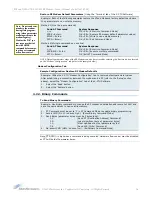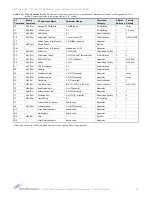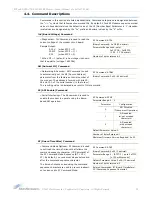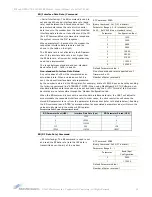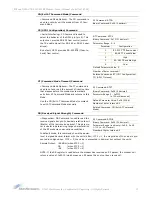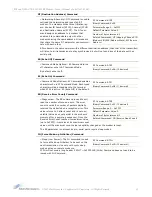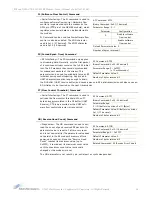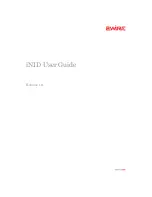
9XTend
‐
NEMA™
RS
‐
232/485
RF
Modem
–
Product
Manual
v2.x4x
[2007.01.04]
©
2007
MaxStream,
Inc.,
Confidential
&
Proprietary
‐
All
Rights
Reserved
36
KY (AES Encryption Key) Command
<Networking & Security> The KY command is
used to set the 256-bit AES (Advanced Encryption
Standard) key for encrypting/decrypting data.
Once set, the key cannot be read out of the
modem by any means. The entire payload of the
packet is encrypted using the key and the CRC is
computed across the ciphertext. When encryption
is enabled, each packet carries an additional 16
bytes to convey the random CBC Initialization
Vector (IV) to the receiver(s). The KY value may
be “0” or any 256-bit value (= 64 hex digits = 32 bytes). Any other value, including entering ATKY
by itself with no parameters, causes an error.
A modem with the wrong key (or no key) will receive encrypted data, but the data driven out the
serial port will be meaningless. Likewise, a modem with a key will receive unencrypted data sent
from a modem without a key, but the output will be meaningless. Because CBC mode is utilized,
repetitive data appears differently in different transmissions due to the randomly-generated IV.
LH (Wake-up Initializer Timer) Command
<Sleep (Low Power)> The LH Command is used
to set/read the duration of time during which the
wake-up initializer is sent. When receiving
modems are in Cyclic Sleep Mode, they power-
down after a period of inactivity (as specified by
the ST parameter) and will periodically wake and
listen for transmitted data. In order for the
receiving modems to remain awake, they must
detect ~35ms of the wake-up initializer.
LH Command must be used whenever a receiving
modem is operating in Cyclic Sleep Mode. The
Wake-up Initializer Time must be longer than the cyclic sleep time that [as determined by SM
(Sleep Mode) parameter]. If the wake-up initializer time were less than the Cyclic Sleep interval,
the connection would be at risk of missing the wake-up initializer transmission.
Refer to figures loated under the SM command description to view diagrams of correct and incor-
rect configurations. The images emphasize that the LH value must be greater than the SM value.
MD (RF Mode) Command
<Networking & Security> The MD command is
used to select/read the settings that enable the
Polling and Repeater Modes on the modem.
Polling Mode - A ‘Polling Base’ is responsible for
polling remotes. A ‘Polling Remote’ requires a poll
in order to transmit.
Repeater Mode - A ‘Repeater’ re-sends RF data
unless the transmission is addressed to it or if the
transmission has already been detected. A
‘Repeater End Node’ handles repeated messages,
but will not repeat the message over-the-air.
Refer to the Polling and Repeater Mode sections of
the ‘RF Communication Modes’ chapter for more
information.
AT Command: ATKY
Binary Command: 0x3C (60 decimal)
Parameter Range:
0 - (any other 64-digit hex valid key)
Default Parameter Value: 0 (disabled)
Number of bytes returned: 2
Number Base: Always Hexadecimal
AT Command: ATLH
Binary Command: 0x0C (12 decimal)
Parameter Range: 0 - 0xFF
[x 100 milliseconds]
Default Parameter Value: 1
Number of bytes returned: 1
Related Commands: HT (Time before Wake-up
Initializer), SM (Sleep Mode), ST (Time before
Sleep)
AT Command: ATMD
Binary Command: 0x31 (49 decimal)
Parameter Range: 0 - 6
Parameter
Configuration
0
Transparent Operation
(Repeater Base)
1
[reserved - not used]
2
[reserved - not used]
3
Polling Base
4
Polling Remote
5
Repeater
6
Repeater End Node
Default Parameter Value: 0
Number of bytes returned: 1
Minimum Firmware Version Required: 2.x20





